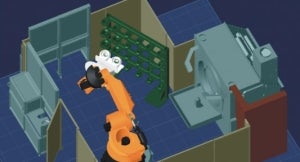
Wheelabrator engineers have developed a new Robot Peener to deliver three times faster process time with complete process reliability.
From the beginning of blasting technology, engineers have wanted to develop a peening machine which combines the advantages of a contour-controlled, precise airblast process with that of efficient wheelblast applications.
The aim is to prolong the service life of the workpiece significantly by transforming compressive stress to tensile stress in a highly effective and efficient shorter process time.
Together with Daimler AG, Gaggenau, a special Shot Peening concept has been developed by the engineers at the Wheelabrator Technology Centre, Metelen, Germany, to increase the fatigue strength of drive/crown wheels in axle gears. The concept is a combination of a high-performance wheelblast machine with a KUKA robot KR 500. The workpiece is manoeuvred into the wheelblast stream with millimetre precision to generate the internal compressive stress in the tooth root of drive/crown wheels.
The concept is completely flexible and can process different workpieces. In a very short timeframe, the robot can change the workpiece holder and process a number of workpieces in quick succession. To achieve this, the robot takes one holder from a magazine and afterwards the relevant workpieces from one of four loading / unloading stations. The selection of workpieces and holders is carried out automatically, following the production control programme.
Flexibility and precision
In one working process the robot can take two axle gear parts with a unit weight of 25kg (maximum). This double action shortens the cycle time per workpiece. After loading, the robot arm docks to a flexible membrane seal in front of the blast wheel. This specially designed seal provides the necessary mobility for the robot, but also avoids media escape during the blasting process so that the robot arm and adjacent machine components are protected from damage. Now the robot can place the workpieces in the optimum position in front of the wheelblast stream. After input of the blasting points, the precise position is automatically calculated. The blasting point is optimised by three-dimensional motions of the robot gripper within the membrane seal.
The robot can move the workpiece during the process so that the surfaces to be peened maintain exactly defined distances to the blast wheel and fixed media impact angles. This ensures a constant blast result, providing the customer’s desired extension of the service life of the product. Furthermore, the concept allows parts to be processed three times quicker than conventionally designed machines.
Please contact Wheelabrator to find out more.

